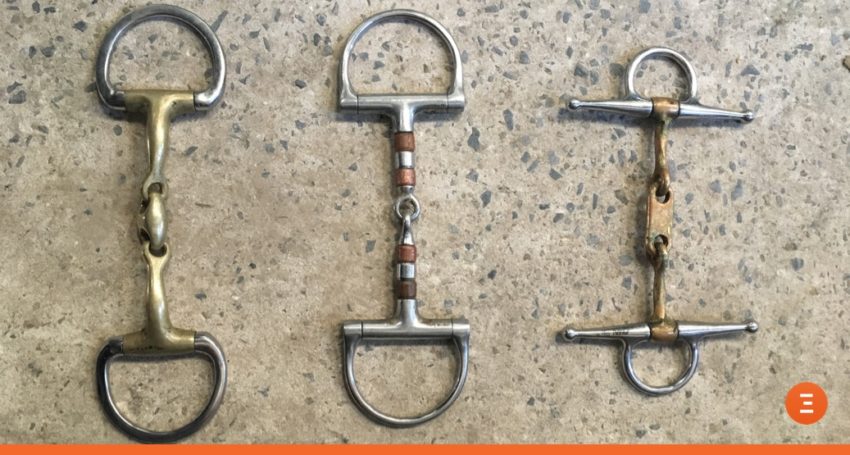
5 Minutes to Understand Bit fitting for your Horse
Putting a bit in your horse’s mouth has become a habit so rooted in our daily life that we often forget that this metal bar is anything but innocuous. A lot of articles spring up on the internet to warn us that bits hurt our horses, and are often highly guilt-creating towards using bits. But few are the articles that actually explain how the bits work and how to chose them.
We won’t mention here bitless solutions because the article would be too long. However, this is something we can talk about later. What we’re going to talk about today is going to be rather: What action do the different bits have? Why should I pick a type of bit or another for my horse? How do I know if the bit I have suits my horse? And this without advocating for one solution or another.
Huge thanks to Géraldine Vandevenne, bitfitter, for proof reading me.

Table des matières
On what anatomical structures does the bit act?
The bit, as it lays in the mouth, is resting on the bars. It’s this space without teeth between the incisors and the molars. The bit acts on key anatomical contact points which are highly sensitive:
- the tongue, muscular, which is more sensitive to pinching than it is to pressure. It’s size varies depending on the horse.
- the corner of the lips are a bit more sensitive
- the bars which are really, really sensitive 😨. It’s actually a mucous membrane lying directly on the lower jaw bone (which is really sharp 🔪)
- lastly, the mandibular nerve which is extremely sensitive. It becomes even more so when trapped against the chin bone and a curb chain. It’s then interesting to have a leather protection (rubber warps and is often too thick). We’ll go back to that later.
We can judge the harshness of a bit without even using it by simply analyzing its impact on every contact point. It is the first step in bit fitting. Remember this: the horse’s mouth is as sensitive as the human’s!
📚 Read more: How mares are different from women
How to choose a bit that fits my horse’s mouth?
That’s a good question, that we should ask ourselves more often. We are always thinking about the action we want the bit to have, but the important thing is to have a bit fitting our horse’s mouth. Here are 3 important points:
- The size of the bit (in mm) has to be chosen according to the ring type. An o-ring snaffle bit have to stick out for 5 mm on each side of the mouth (or else you risk pinching the skin). An eggbutt snaffle bit has to stick out for only about 2 mm 📏
- The thickness of the mouthpiece has to be adjusted to the mouth. To check this, open your horse’s mouth around the bars when its mouth is closed. The mouthpiece can’t be bigger than the space between the two bars or else the horse simply can’t close its mouth. The thickness of the mouthpiece also has to take into account the thickness of your horse’s tongue and in doing so, the free space in the mouth.
- The height of the bit (which you will adjust with the cheekpieces). It has to be adjusted so the bit isn’t in contact with the teeth (incisors or molars). This way, according to your horse’s mouth, you’ll have a different number or folds at the corner of the lips. We usually go for 2 folds, but you have to adjust to your horse. Some need 0 folds, some need 4.
How do plain bits act?
Let’s dive into the heart of the matter. A plain bit (so with a single ring and no curb chain) acts mainly on the corner of the lips. But be careful: this depends on the angle between the head and the neck. Or rather, the angle between its mouth and your hands!
The more the mouth is parallel to your hands (neck extension or high hands), the more you’ll act on the corner of the lips. If the mouth is perpendicular (horse behind the vertical or hands very low) the action will only be on the bars.


Why are the mouthpieces shaped weirdly?
The shape of the mouthpiece changed everything. Firstly, the number of “joints” on the mouthpiece is important.
Straight bar bits
A straight bar bit acts more on the tongue. The tongue cushions the bit’s action away from the bars. These bits however lack precision because both sides aren’t separated. They are said to be softer but not all horses can handle the pressure on their tongue.
The impact on the tongue can have big repercussions on locomotion. Indeed, the tongue is attached to the hyoid bone. It’s linked to muscles going towards the sternum and is articulated with the skull. So the tongue isn’t just in the mouth…

Jointed bits
Jointed mouthpieces (single or double jointed) will fold in the middle when the rider acts with its reins. Depending on the shape of the bit and the rider’s hand position towards the mouth, they can create a point which will press on the horse’s palate. However, their actions on the bars will be different.
Single jointed bits can have a “nutcracker” effect depending on the rides hand position. This creates a pression on the horse’s bars by “freeing” the tongue.

A double jointed bit will be more precise since the two sides will be separated better than with a straight or single jointed bit.
 Other bits
Other bits
You can also find mouthing bits to help the horse relax, or spoon bits to prevent the horse from getting its tongue over the bit. However be aware that if a horse tries to get its tongue over the bit, it’s because its hurting! So keeping it from getting its tongue over the bit won’t solve the problem. Medium port bits will free the tongue bit they will increase pressure on the bars. These bits however have a relatively small tongue space, therefore they can’t free the whole tongue.
Let’s also keep in mind that the thinner the mouthpiece, the harsher the action is. Indeed, when the contact area is reduced, the pressure rises. Also, a small reminder of elementary physics: Pressure = Force / Surface. So to lower the pressure, either you diminish the force or you increase the contact surface.
In this case for twisted mouthpieces with sharp edges the bit can become extremely severe… 😱
What does the ring shape change?
According to the type of bit, the rings will slide or won’t.
If they don’t slide, like with a eggbutt or a d-ring, the time delaying the rider’s hands action on the horse’s mouth will be decreased. That’s what makes them more accurate.
The shape of the ring in itself (D-ring, full cheeks, half cheeks) will influence the ease to lead the horse. If the ring is bigger, the rider’s hands action will be received by a bigger zone of the horse’s mouth and it will be easier to choose a direction.

If the half cheeks’ ring is flat, it softens the action (contact zone increased = pressure decreased). By the way if, like I did, you’ve wondered about this for a while: if the half cheeks ring goes downwards, its only action is to stop the bit from leaving the horse’s mouth. However if it goes upwards, it has the same action as a full cheek.
How do a Pessoa or a Pelham act on my horse’s mouth?
What’s important in these bits, it’s whether or not they have a curb chain.
Bits without curb chains (Baucher, Pessoa…)
For bits with no curb chains (Baucher or Pessoa bits for instance), when the rider acts with their hands the upper ring (where the cheek piece hangs) will shift forward. This will apply pressure on the base of the neck and the horse will lower its head. The bit goes up in the mouth to act on the corner of the lips. ⇒ That’s the elevating action.
This action will be stronger if the upper ring is long or has an important diameter. The longest, the more the bit will rise up and act on the neck.
Curb chains bits (Pelham, Goyo, Lhotte…)
When there is indeed a curb chain (like with a Pelham bit), the upper ring will tilt forward and put pressure on the back of the neck the same way. However the bit won’t be able to go up because of the curb chain. It will instead press harder on the bars, and the curb chain will compress the bone and the mandibular nerve. The horse won’t have a choice than to close it’s head-neck angle to avoid this harsh action. ⇒ That’s the lowering action.
This way the lower you attach the reins (so the branch is longer), the stronger the action. A reminder that a well adjusted curb chain only tenses when the branch has a 45° action in the mouth.

What difference between the materials?
There are indeed a lot of different materials. Steel, Copper, Rubber, Plastics…
What’s important is:
- Black rubber can cause chaffing
- Plastics deteriorate easily and can cause lining sores
- Leather is often too big and the seams can be uncomfortable. Also the leather is chemically treated…
- Copper (never used alone, only as an alloy) makes the horse salivate and helps with relaxation
- Nickel, used in a lot of alloys (like brass) can be allergenic to some horses
- Alloys in general are softer. Some conduct heat better or can be lighter.
A little advice: when it’s cold outside, try to heat up the bit before putting it in your horse’s mouth. It’s not great to suck on ice cubes mid-winter! ☃
Conclusion
Bit fitting is really important. This choice should be made by taking into account your horse’s preferences and their own anatomy. Your horse might not be able to handle a “softer” bit. It’s better to use a more severe bit when it’s well adjusted and your horse enjoys it, than using a softer bit not suited to its mouth. Let’s also keep in mind that the bridle also has an important impact on your horse’s relaxation. If you have any doubts, don’t hesitate to contact a bitfitter: that’s their job! They will try to help you find a good compromise for the horse and rider by taking into account the couple’s age, level, and field. While trying to avoid the vicious spiral of harsher and more severe bits.
A bit will be soft if it fits the horse and the rider.
The issue of a harsh hand
What is important in terms of bit fitting is : the adjusting, the type of bit, the material… but at the end of the day, the hand at the end of the reins is what counts the most. A studied showed it: if the tension in the reins is too important, the behavior (teeth grinding, tongue over the bit…) will continue even after you change the bit (Manfredi et al.,2010). So if your horse opens its mouth on its bit, or grinds its teeth, or any other defensive behavior, ask yourself this: is the bit adjusted and did I chose the right one? is my horse hurting somewhere? But most importantly: is my hand too harsh?
If you remove any problems linked to adjusting and changing the bit, tightening the noseband won’t solve anything. No foot, no horse, but no mouth no horse either. So to a severe bit, a soft hand, and to a soft bit… a soft hand as well!
“Having a plethora of contrivances to control the horse doesn’t allow us to hear it. You can’t listen to a horse you silence.” Général d’Aure.
Camille Saute
R&D leader at Equisense
 Other bits
Other bits